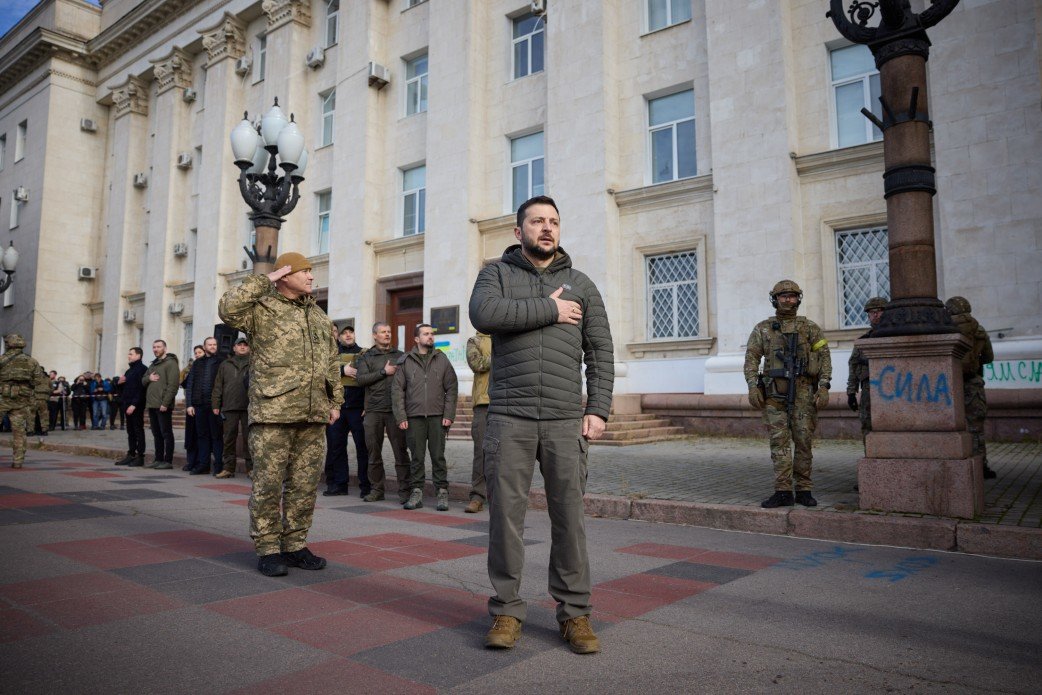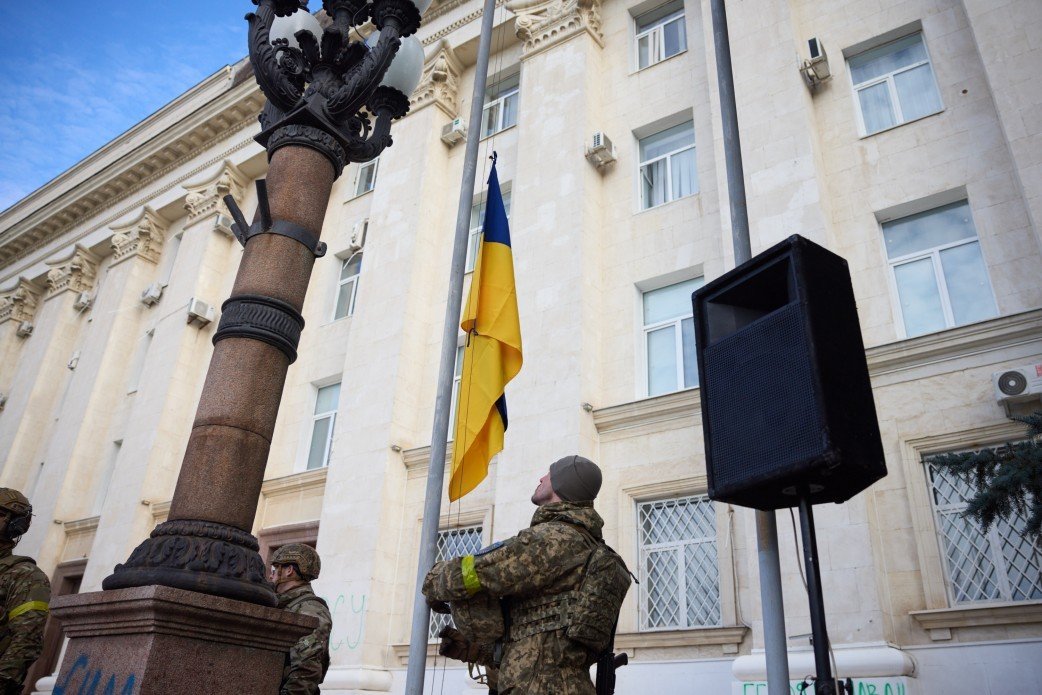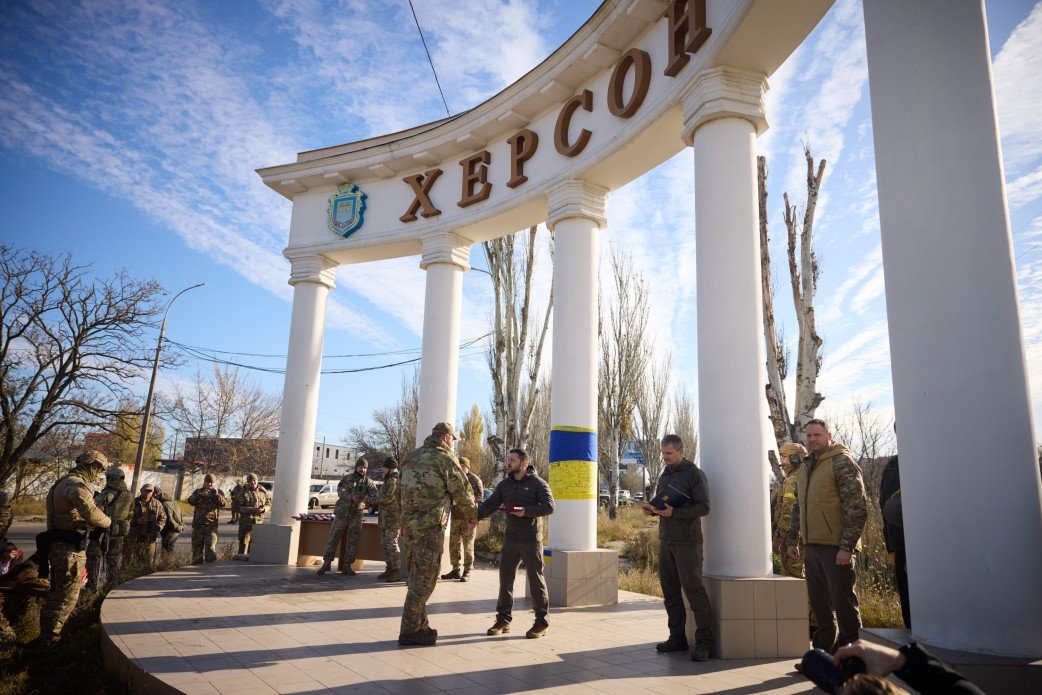Ukraine Liberated Kherson, but a Winter Lull in Combat Appears Unlikely

Ukrainian President Volodymyr Zelenskyy visits liberated Kherson on Nov. 14, 2022. Photo courtesy of the Office of the President of Ukraine.
In early March, shortly after Russian troops took over, thousands of civilians marched in protest through Kherson’s city center. They brought Ukrainian flags and chanted things like "Russians go home" and "Kherson is Ukraine.”
With a prewar population of nearly 300,000, this city in southern Ukraine endured eight months under Russian occupation. During that time, many residents suffered arbitrary arrests, persecution, rape, and torture. A glimmer of hope emerged at the end of August, when Ukrainian forces began their southern offensive aimed at taking back Kherson. Yet, while Ukrainian troops steadily liberated nearby settlements, the city’s civilians lived under the specter of a possibly apocalyptic urban battle.
That climactic showdown never happened. In a choreographed meeting broadcast Wednesday, Nov. 9, on Russian TV, Moscow’s top brass announced Russian forces’ withdrawal from Kherson. The televised meeting of Russian Defense Minister Sergei Shoigu and Gen. Sergey Surovikin, the commander of Russian forces in Ukraine, was likely meant to distance Russian President Vladimir Putin from the debacle, many experts believe.

A Ukrainian soldier raises his country's flag in Kherson on Nov. 14, 2022. Photo courtesy of the Office of the President of Ukraine.
On Friday, an advanced guard of Ukrainian troops, facing little or no resistance, entered Kherson. Shortly thereafter, social media channels flooded with videos of Ukrainians filling Kherson’s main square to greet their liberators. On Monday, Ukrainian President Volodymyr Zelenskyy arrived in the city; jubilant crowds greeted their wartime leader.
“This is the beginning of the end of the war,” Zelenskyy said during the visit. “We are step by step coming to all the temporarily occupied territories.”
During a Sunday evening national address about Kherson’s liberation, Zelenskyy said retreating Russian forces left behind evidence of war crimes — a grim fact that has become par for the course as Russia’s military retreats from the high-water marks of its invasion.
"The Russian army left behind the same savagery it did in other regions of the country it entered," the Ukrainian president said on Sunday. "We will find and bring to justice [to] every murderer. Without a doubt."
Withdrawing Russian forces destroyed much of Kherson’s utilities, including electricity, cellular communication, and running water. Despite the spare living conditions, city residents clearly showed their elation after the arrival of Ukrainian troops. Scenes of celebration sharply contrasted against fresh memories of the anti-Russian protests at the war’s outset in February and March. This stark disparity repudiates Russia’s claims that people in this Ukrainian region, as well as others under Russian occupation, harbor some latent desire to split from Ukraine and join the Russian Federation.
“The 264th day of the war with the Rashists. The Ukrainian president arrived in Kherson, Ukraine. The blue-yellow flag was officially raised. Instead of the flagpole that fell last year, a new one will be installed … And how many times did Russian President Putin visit the supposedly 'liberated' city annexed to Russia?” Sergey Khlan, deputy of the Kherson Regional Council, wrote Monday on Facebook.
Kherson was the only regional capital that Russian forces seized after the Feb. 24 full-scale invasion. During a bombastic Kremlin ceremony five weeks ago, Putin proudly proclaimed Moscow’s annexation of Kherson, as well as other swaths of occupied Ukraine.
Putin declared that Kherson and other occupied Ukrainian regions would “forever” be part of the Russian Federation; he also hinted that any Ukrainian offensive to take back those allegedly annexed regions might provoke a Russian nuclear response. As of this article’s publication, Russia has not resorted to weapons of mass destruction to halt Ukraine’s liberation of Kherson.
Since April, Ukrainian forces have retaken more than 25,000 square miles of territory previously under Russian occupation. By that measure, Russia has lost roughly half of the territory it controlled at the invasion’s peak in March. Recent Ukrainian advances in the Kharkiv region resulted in wholesale routs of Russian forces, marked by chaotic retreats and mountains of abandoned equipment and weaponry. The Russian retreat from Kherson was more methodical, underscoring a command-level acceptance that their position in the city was logistically untenable.

Ukrainian President Volodymyr Zelenskyy visits liberated Kherson on Nov. 14, 2022. Photo courtesy of the Office of the President of Ukraine.
The steady supply of advanced Western weapons, such as American M142 HIMARS rocket launchers, allowed the Ukrainians to conduct a campaign of precision targeted strikes on Russia’s logistics hubs and supply routes in the Kherson region. Notably, the Ukrainians continuously targeted bridges spanning the Dnipro River, imperiling the escape routes for Russians on the western bank of the Dnipro River where the city center of Kherson is located.
Those attacks amounted to a logistical tourniquet for Russian forces in Kherson. Rather than face encirclement and annihilation, the Russians chose to retreat to the eastern bank of the Dnipro River. In liberating Kherson without a drawn-out siege, Ukrainian units proved the utility of Western weapons in sparing civilian casualties.
Kherson marks a major morale victory for Ukrainian troops, as well as for civilians hunkered down nationwide amid a sustained Russian missile and exploding drone campaign against the country’s power grid. This latest Ukrainian victory also deals a psychological blow to the tens of thousands of freshly mobilized Russian troops, many of whom were press-ganged against their will into combat service and now face shortfalls of supplies and training. Looking ahead to winter, Russian morale is not likely to rebound quickly or easily. Moreover, the war is not likely to taper off during the cold weather.
"The Ukrainians will almost certainly continue their counter-offensive operations already underway," the Institute for the Study of War reported on Nov. 13. "Combat is more likely to intensify than to slacken as temperatures drop."
Russia still controls about 60% of Ukraine’s Kherson region to the south and east of the Dnipro River. Now squarely on the defensive, those units are digging in on the river’s eastern bank. Moscow’s most likely objective at this point in the war, some experts argue, is to stall further Ukrainian advances long enough for more materiel and mobilized recruits to percolate out to the front lines.
A winter lull in fighting would allow the Russians to regroup, materially and morally, after a succession of major defeats. Moreover, an offensive pause would allow the Russian side to further entrench its positions, stalling long enough for the ink to dry on Moscow’s proclaimed territorial conquests ahead of any prospective peace negotiations with Kyiv.
Enjoying advantages in supply and morale, Ukrainian forces will likely press their advantage regardless of the weather. Even so, a direct offensive across the Dnipro River against hardened Russian defenses would be a costly gambit for Ukraine’s military. For that reason, many experts believe Ukrainian units may attempt to flank Russian forces in the south by attacking from the Zaporizhzhia direction, or by landing on the Kinburn Peninsula at the mouth of the Dnipro River in the Black Sea.
According to the Institute for the Study of War: "The Ukrainians will likely use combat power recouped from the liberation of western Kherson to reinforce their ongoing counter-offensive in Luhansk Oblast or to open a new counter-offensive drive elsewhere."
Addressing the damage left behind by Russian forces in Kherson, Zelenskyy said on Monday: "This is what the Russian Federation did in our country, it showed the whole world that it can kill. But all of us, our Armed Forces, our National Guard, intelligence have shown that it is impossible to kill Ukraine.”
Read Next: The Story of Ukraine’s ‘Survived’ Wines

BRCC and Bad Moon Print Press team up for an exclusive, limited-edition T-shirt design!
BRCC partners with Team Room Design for an exclusive T-shirt release!
Thirty Seconds Out has partnered with BRCC for an exclusive shirt design invoking the God of Winter.
Lucas O'Hara of Grizzly Forge has teamed up with BRCC for a badass, exclusive Shirt Club T-shirt design featuring his most popular knife and tiomahawk.
Coffee or Die sits down with one of the graphic designers behind Black Rifle Coffee's signature look and vibe.
Biden will award the Medal of Honor to a Vietnam War Army helicopter pilot who risked his life to save a reconnaissance team from almost certain death.
Ever wonder how much Jack Mandaville would f*ck sh*t up if he went back in time? The American Revolution didn't even see him coming.
A nearly 200-year-old West Point time capsule that at first appeared to yield little more than dust contains hidden treasure, the US Military Academy said.












